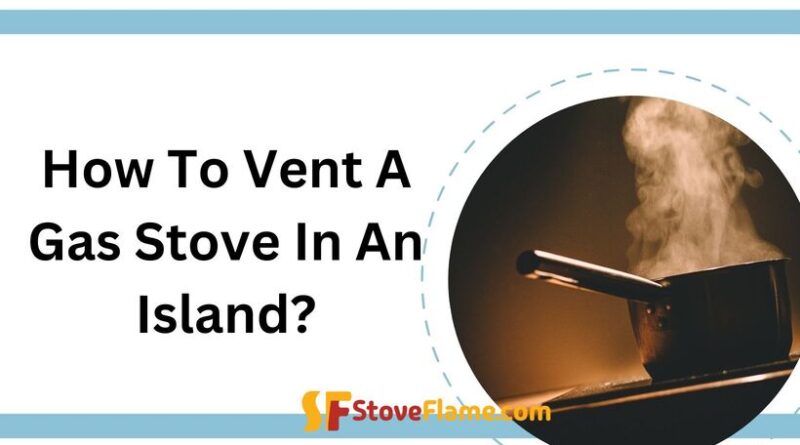How To Vent A Gas Stove In An Island?
A gas stove in an island can be a beautiful and functional addition to any kitchen. With its sleek and modern design, it provides a seamless cooking experience and opens up the space for more creativity in kitchen design.
However, the installation of a gas stove in an island comes with its own set of challenges, particularly in venting. Adequate ventilation is crucial for the safe operation of a gas stove, as it helps remove harmful gases and odors from the cooking area.
This article aims to explore the different venting options available for gas stoves in an island setting and offer a detailed guide on the proper installation of a ventilation system. Whether you are a homeowner contemplating a kitchen remodel or a contractor seeking expert guidance, this resource is designed to equip you with the essential knowledge required for a secure and effective gas stove installation. Let us now delve into the intricacies of venting a gas stove in an island configuration.
Gas Stoves in Islands
When it comes to designing a functional and stylish kitchen, many homeowners opt for a gas stove in their island. Gas stoves offer precise temperature control and instant heat, making them a popular choice for cooking enthusiasts.
However, it’s important to address the ventilation concerns that come with placing a gas stove in an island. Proper ventilation is essential to remove smoke, odors, and harmful gases from the cooking area.
There are several options available to effectively vent a gas stove in an island, such as installing a downdraft ventilation system or utilizing a ceiling-mounted hood. These solutions ensure that your kitchen remains odor-free and safe, allowing you to enjoy the benefits of a gas stove in your island without compromising on air quality.
Importance of Properly Venting a Gas Stove in an Island
One cannot underestimate the importance of properly venting a gas stove in an island. Without proper ventilation, the smoke, odors, and harmful gases produced during cooking can accumulate in your kitchen, leading to poor air quality, lingering smells, and potential health hazards.
By installing an effective ventilation system, you can ensure that these byproducts are promptly removed from the cooking area, keeping your kitchen fresh and safe. Additionally, proper ventilation prevents the buildup of excess moisture, which can lead to mold and mildew growth.
So, whether you opt for a downdraft ventilation system or a ceiling-mounted hood, investing in proper ventilation for your gas stove in the island is crucial for maintaining a healthy and pleasant cooking environment.
How To Vent a Gas Stove in an Island?
When it comes to understanding gas stove ventilation, it’s important to consider the specific layout and design of your kitchen. Proper ventilation ensures that the smoke, fumes, and odors generated while cooking are effectively removed from the space.
If you have a gas stove in an island, you’ll need to carefully plan for ventilation options that suit this setup. One popular choice is a downdraft ventilation system, which is installed directly behind or within the stove itself. This system pulls the air downwards and out through ductwork or a vent located beneath the floor.
Alternatively, you can opt for a ceiling-mounted hood that efficiently captures and removes the cooking byproducts. Whichever option you choose, it’s crucial to consult with a professional to ensure proper installation and sizing based on your specific kitchen layout and ventilation needs. By understanding gas stove ventilation and implementing the appropriate system, you can enhance air quality, eliminate odors, and create a safe and enjoyable cooking environment in your island kitchen.
Another effective option for venting a gas stove in an island is to install a pop-up ventilation system. This discreet solution is designed to rise up from the countertop when in use and then retract back down when not needed. This type of ventilation system typically uses powerful fans and filters to effectively remove smoke and odors from the cooking area.
The advantage of a pop-up ventilation system is that it offers efficient ventilation without obstructing the view or taking up valuable space in your kitchen. However, it’s essential to ensure proper installation and regular maintenance to keep the system functioning optimally.
Factors to Consider Before Vent a Gas Stove in an Island
Before venting a gas stove in an island, there are several important factors to consider. First and foremost, you need to evaluate the layout and size of your kitchen. Is there enough space in the island for proper ventilation installation?
Additionally, you should assess the proximity of nearby walls, cabinets, or windows, as this may affect the placement and effectiveness of the ventilation system.
Another crucial consideration is the local building codes and regulations regarding gas stove venting. Ensure that you comply with these standards to guarantee safety and prevent any potential issues in the future.
Furthermore, it is essential to think about the power source for the ventilation system. Will it be connected to an existing ductwork or does it require a separate exhaust system?
Lastly, budget and personal preferences also play a role. Evaluate your options and weigh the benefits of different ventilation methods, such as downdraft systems, overhead hoods, or pop-up vents, to find the most suitable solution for your gas stove in an island.
Advantages And Disadvantages Of Downdraft System
When considering how to vent a gas stove in an island, it is important to understand the advantages and disadvantages of the various ventilation options available.
One advantage of a downdraft system is its sleek and unobtrusive design, as it can be hidden within the countertop when not in use. This can be particularly beneficial if you have limited space or prefer a minimalist aesthetic in your kitchen.
On the other hand, one disadvantage of a downdraft system is that it may not be as effective in capturing and removing smoke, odors, and heat as an overhead hood.
Additionally, downdraft systems can be more expensive to install and may require regular maintenance to ensure optimal performance. Ultimately, the decision on how to vent your gas stove in an island should be based on your specific kitchen layout, personal preferences, and budget constraints.
Regular Cleaning and Use Carbon Monoxide Detectors
To ensure the safe operation of your gas stove in an island, it is crucial to prioritize regular cleaning and the use of carbon monoxide detectors. Regular cleaning of your gas stove not only helps to maintain its efficiency but also reduces the risk of potential hazards. Make it a habit to clean the burners, grates, and oven regularly, using appropriate cleaning agents and techniques recommended by the manufacturer.
Additionally, it is essential to install carbon monoxide detectors in your kitchen and other areas near the gas stove. These detectors can alert you to the presence of this odorless and potentially lethal gas, giving you crucial time to evacuate and seek help if necessary.
Remember to check the batteries and test the detectors regularly to ensure they are in proper working condition. By incorporating regular cleaning practices and utilizing carbon monoxide detectors, you can enjoy the convenience of a gas stove in your island while prioritizing the safety of yourself and your household.
Ensuring Proper Air Flow
Proper air flow is another critical aspect to consider when venting a gas stove in an island. Adequate ventilation helps to eliminate odors, smoke, and potentially harmful gases, ensuring a safe and comfortable cooking environment.
One effective way to ensure proper air flow is by installing a range hood above the gas stove. A range hood with a powerful exhaust fan will help to capture and remove airborne particles and pollutants, preventing them from circulating in your kitchen. It is important to choose a range hood that is appropriately sized for your gas stove and complies with local building codes.
Additionally, regularly cleaning and maintaining the range hood, including replacing or cleaning filters, is essential to maintain its effectiveness.
Precautions and Safety Tips
When venting a gas stove in an island, it is crucial to prioritize safety precautions. Firstly, ensure that the gas stove is installed by a qualified professional who can properly connect it to the gas supply line. Regularly inspect the gas connections for any signs of leakage or damage, such as hissing sounds or the smell of gas. In case of any suspicion, immediately turn off the gas supply and contact a professional for assistance.
Additionally, it is important to keep flammable materials and objects away from the gas stove, as they can pose a fire hazard. Always use heat-resistant materials for the island countertop and surrounding surfaces to minimize the risk of accidental burns or damage.
Lastly, be mindful of proper ventilation and adequate clearance around the stove to prevent overheating and ensure proper air flow. By following these precautions and safety tips, you can enjoy the convenience of a gas stove in your kitchen island while minimizing potential risks.
Conclusion
As we come to the end of this guide, it’s important to remember that venting a gas stove in an island can be a complicated process, but it is not impossible. With the right tools and knowledge, you can successfully install a vent for your gas stove in your kitchen island. Always be sure to follow safety precautions and consult a professional if needed. With a little bit of patience and effort, you’ll have a properly vented and functional gas stove in your island in no time.
I'm Daniel Miller, the proud owner of StoveFlame. With over five years of experience in this dynamic field, I've honed my skills and passion for delivering top-notch quality and accuracy in everything I do.





